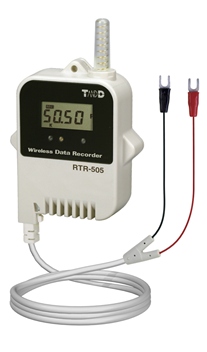This summer, CAS DataLoggers recently supplied the wireless datalogging solution for a middle school maintenance supervisor who needed to perform power factoring on the building’s HVAC system before winter arrived.
The school needed a lightweight yet affordable monitoring system that could connect to most available power meters to measure the system’s pulse output. The supervisor also needed this device to be
compatible with other datalogging models to measure other parameters in future, including temperature from ducts, the humidity of the airstream from vents, etc. A wireless solution would be ideal to provide coverage in remote spots. Early on in the selection process, the supervisor realized that he was also going to need some technical support to get his project up and running ASAP before autumn arrived and heating costs rose.
 T&D RTR-505-P Wireless Pulse Datalogger.
T&D RTR-505-P Wireless Pulse Datalogger.
The school installed 4 T&D RTR-505-P Wireless Pulse Dataloggers along with an RTR-500 Wireless Base Station to monitor its total and localized HVAC system energy usage using pulse output, connecting these remote units to energy meters via several Continental Control Systems WattNode WNC-P devices sampling 1 pulse per every watt hour. In this way the wireless loggers performed automatic power monitoring--every hour users saw the energy consumption over the previous hour and could freely scale the result.
Using the included software, users converted these pulses back into energy to view kilowatt hours as a result. Additionally, staff could easily combine the remote unit with other T&D dataloggers to measure other parameters including temperature and humidity, giving the supervisor a flexible system to handle several different applications.
The compact T&D pulse data loggers recorded the changes in pulse count for thermostat and switch contact signals and the Lo/Hi voltage signals that occurred during the user-set recording interval. The remote units also allowed for a wide variety of commercially available sensors to be connected to the included input module, widening the range of measurable values.
Measuring voltage signals from 0 to 27V with a pulse response with a low of 0.5V or less, high of 2.5V or more, and a maximum pulse response of 3,500 pulses per second, the data loggers could each store 16,000 readings to keep logging for extended periods. The loggers’ clear LCD displays showed current readings along with status, logging capacity, measurement range exceeded, and more, and the dataloggers also offered options for wall brackets to cover all the out-of-the-way spaces.
Using the T&D monitoring system, it was simple for the supervisor to instantly download all the data via wireless communication using the wireless base station. The wireless communication range between a Remote Unit and a Base Unit was about 500 feet (150 meters), and this range could easily be extended by simply registering an RTR-500 as a Repeater to expand coverage. The datalogger’s large logging capacity allowed users to set a recording interval of once an hour and keep monitoring for 665 days. It only took about two minutes for a Base Unit to finish wirelessly downloading one RTR-505 Remote Unit at full logging capacity. Data could also be collected remotely via USB and LAN.
Utilizing a low energy consumption design, the data loggers’ lithium batteries had an estimated battery life of about 10 months operating at normal temperature. If the contractor needed to extend logging duration, T&D “L” model loggers featured a large capacity battery pack so that under the same conditions they could continue for about four years to save workers the trouble of replacing the battery.
The middle school’s wireless system was installed in late summer and began identifying areas for energy savings by mid-autumn. The data loggers and the wireless base station proved to be a cost-effective solution for the school’s energy monitoring project, and data collection and organization was a snap with the loggers’ wireless capability.
For more info on our wireless data loggers measuring pulse, temperature, humidity, and many other parameters, or to find the ideal device for your application-specific needs, contact a CAS Data Logger Applications Analyst at (800) 956-4437 or visit the website at www.DataLoggerInc.com.